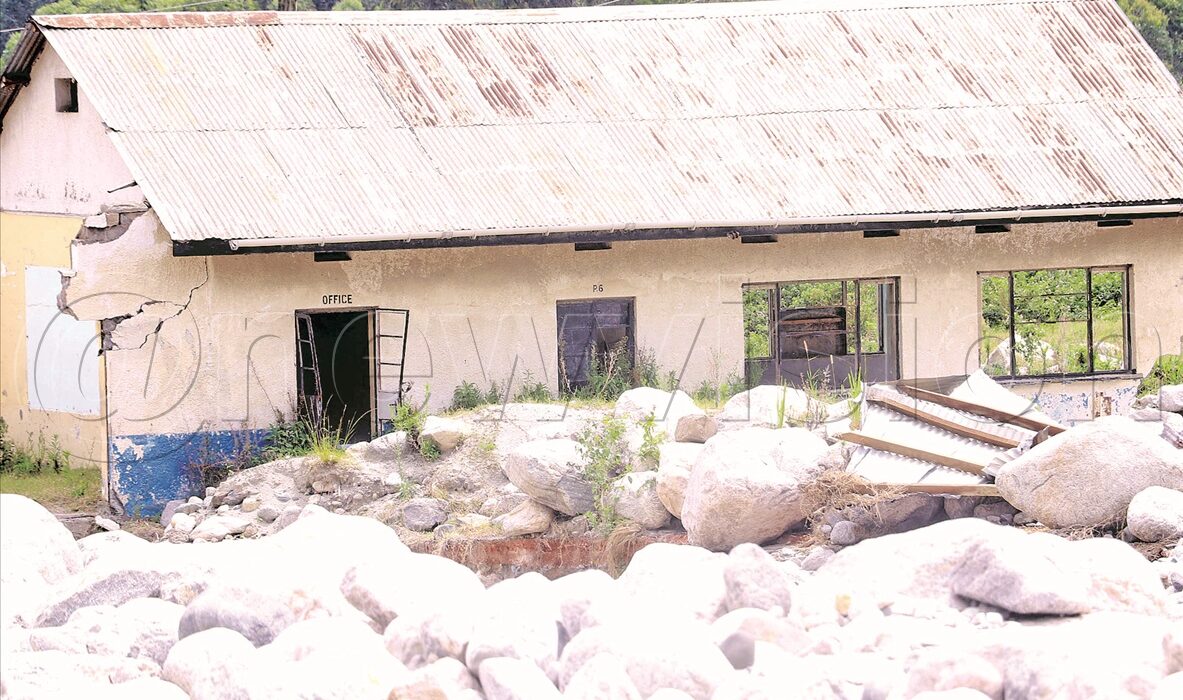This article was first published in the New Vision on October21, 2021
By Conan Businge
After months since River Nyamwamba floods swept away schools in Kasese district, affecting over 5,000 students, Vice-President Maj. (Rtd) Jessica Alupo has said they will be reconstructed. She made the remarks during her trip to the district, last week, to assess the effects of the floods and how Kilembe Mines can be revamped.
Alupo said she will follow up on the matter with the education ministry and have 10 schools reconstructed. She added that Kilembe Hospital, which was affected by the floods, would also be restored.
Genesis Of The Crisis
It all started with thunder. Loud and heavy sounds started emanating from the far end of the mountain ranges, and the residents knew that the floods were about to sweep their homesteads away.
Many of them scampered to the upper parts of the hills, with others steering clear of the river banks. This was the case in 2011, 2012 and 2013, when rivers left communities on the Rwenzori mountain ranges devastated.
However, this time round, it was not only River Nyamwamba at it. There were three other rivers — Mubuku, Nyamugasani and Lhubiriha — which on May 10 burst their banks and swept through villages.
The floods swept off eucalyptus forests, homesteads, schools and gardens. Rubble, as big as small cars, moved down the stream, leaving a trail of destruction. A total of 11 schools were affected.
District officials say at least seven villages in Karambi sub-county and five in Kitholhu, both in Bukonzo West constituency, were affected.
This happened during the lockdown instituted to curb the spread of COVID-19. However, it was partly a blessing since children were not at school. In Bukonzo East constituency, 86 households in Kisinga town council were also displaced when River Rwembya burst its banks.

Schools Affected
Most of the affected were primary schools. Many of them were destroyed and the debris swept off. Others were partially destroyed, losing a few buildings.
The schools that were affected include Kilembe Secondary School which had 637 students, Kyanjuki Primary School (616 pupils), Bulembia Primary School (784 pupils), Mt Rwenzori Girls Secondary School (319 students) and Katiri Primary School (400 pupils).
Others were Road Barrier Primary School (441), Kisabu Primary School (200), Nyamwamba Primary School (500), Kanyangeya Primary School (403), Royal Ranges Secondary School (400), Masule Primary School (200) and Mburakasaka Primary School (350).
The floods swept away the playground and eucalyptus tree forest of Kisabu Primary School in Kitolhu sub-county, at the border of Uganda and the Democratic Republic of Congo.
This was after River Riviriha, which is a tributary of River Nyamwamba flooded.
Local authorities say the river changed its course and, since it was being used as an international boundary mark, it left almost half an acre of Uganda’s land in the Democratic Republic of Congo.
To make matters worse, some of the schools which were operating as quarantine centres were also flooded prompting the district leaders to transport the affected people to other temporary centres.
Restoration Of The Schools
As the Government’s move to restore the schools and infrastructure, several ministers and technical teams from the Office of the Prime Minister and education ministry, among others, have been on the ground to assess the situation.
President Yoweri Museveni also flew to the area to assess the situation.
Last year, state minister for higher education Dr John Chrysostom Muyingo and a technical team of commissioners and senior staff who included the assistant commissioner for schools, Alfred Kyaka, toured Kasese to assess the situation.
Muyingo, while addressing district leaders, said the Government would immediately revamp and reconstruct the affected schools. “Some of the schools, on agreement with local leaders, may have to be reconstructed in different places, away from the path of the rivers,” he said.
Muyingo informed New Vision that the damage and the reconstruction assessment report was done and that it would soon be handed over to the education minister.
The commissioner of education standards, Benson Baritazale Kule and the commissioner for business, technical vocational education and training, Hajat Safina Musenne who was representing the education ministry’s permanent secretary, also visited Kasese last week.
Managing School Disasters
Relief Web, a humanitarian information source on global crises and disasters, reports that annually, nearly 40 million children have their education interrupted by natural disasters, such as earthquakes and disease outbreaks.
They say the impacts on children and young people’s education can be profound, with the poorest and most marginalised, including girls, most at risk. The devastation is often most severe and long-lasting in contexts where education capacity and resources are already low.
The recent latest big-scale natural disaster was Cyclone Idai, described by the United Nations as “one of the deadliest storms on record in the southern hemisphere”. Hundreds of schools in Mozambique, Malawi and Zimbabwe were destroyed. Due to the high cost of reconstructing schools, they had to start with temporary structures for some years, with the support of local and international education funding organisations.
Other Issues Raised
Muyingo, during the tour, was also bothered by the low performance of the district in the national examinations, especially at primary level.
“For the last two years, less than 10% of the pupils have been passing in Division One in the national examinations. This is worrying because, even if we work on the infrastructure, a lot needs to be done to improve this district’s quality of education,” he notes.
The mayor of Kasese town, Godfrey Kabyanga, says apart from schools, the Government needs to reconstruct the roads and bridges which were swept away by the floods since they will be vital for the reconstruction of schools and the students to reach their institutions of learning.
During the inspection, the team used temporary bridges to cross River Nyamwamba and, in certain cases, they would climb through village paths, to get to schools at the top of the hill.
Alice Kyakuwa, a parent, says: “We will still appeal to the Government to help us construct roads, bridges, water points and electricity for us to return to normalcy.” She asked the minister to avail the district with funds to help people in the hills to restore their life to normal.
Experts Speak Out
The commissioner for business, technical vocational education and training, Hajat Safina Musenne, says it is important to urgently rebuild schools as they need to be ready before they are reopened in January next year. She says the technical team has assessed the damage and that the report was submitted to the Office of the Prime Minister since it partly handled emergencies and disaster preparedness and mitigation issues.
However, to construct a secondary school in such a hilly area, the ministry needs about sh2b. For the schools that were partially destroyed, sources in the ministry estimate that it may cost sh1b for each. Sources in the construction unit in the education ministry said the schools will cost about sh12b to be reconstructed. To set up a primary school, the Government spends about sh1b, with seven classrooms, an office and latrines, according to details obtained from the education ministry’s planning unit.
“Since nine primary schools were destroyed and the area being hilly, the ministry is likely to spend at least sh10.8b on reconstructing them,” a source says. This would mean that the ministry must have at least sh13.8b to revamp the schools which were destroyed by the floods.

